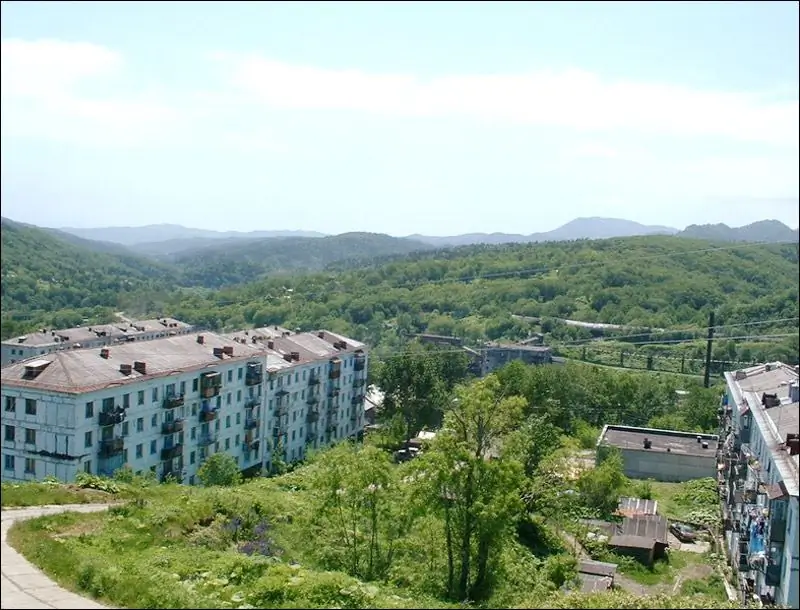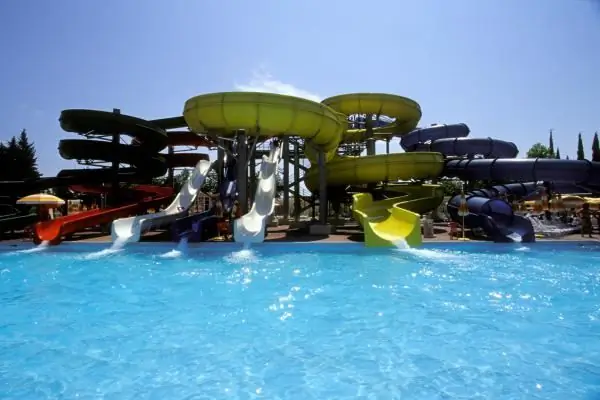- Author Harold Hamphrey [email protected].
- Public 2023-12-17 10:06.
- Last modified 2025-01-24 11:10.
Alexander Park (Tsarskoye Selo) is part of a state-protected museum-reserve located near St. Petersburg. Built in the 18th-19th centuries, the museum is one of the most frequently visited attractions in Russia, with up to 100,000 visitors annually.

Where is it?
Alexander Park, Tsarskoye Selo, Catherine's Palace - all these objects are located in the Leningrad region, in the small town of Pushkin. Until 1918, the settlement was called Tsarskoye Selo, it was founded as a country residence for the imperial family, and later most of its houses became a monument of urban building art.
Pushkin received city status in 1808 and has been actively developing ever since. Its main plus is its convenient location relative to St. Petersburg (only 23 kilometers). As of 2015, about 100 thousand people live in the city, and the population is graduallyincreasing.
How to get there?
The city where Alexander Park (Pushkin) is located is easily accessible for guests and residents of St. Petersburg. Within the settlement there are two railway stations at once - "21st kilometer" and "Tsarskoe Selo", which can be reached by trains departing from the Vitebsk station of the Northern capital. Electric trains in this direction run at intervals of 15 minutes to an hour.
You can also take fixed-route taxis No. 545, 342, 287 and 347, as well as bus route No. 187, the starting point of their departure is the Moskovskaya metro station. If you are traveling by car, it is best to use the Pulkovsky highway or Vitebsky prospect. Experienced tourists do not advise driving along the Moscow highway, as there is a very high risk of getting stuck in a traffic jam for a long time.

Historical reference (before 1740)
At the beginning of the 17th century, at the place where Alexander Park welcomes guests today, there was the Sarskaya Manor, a manor that belonged to a Swedish magnate. In some maps, it is called Saritsa. When the Swedes were expelled from the area, the manor was donated to A. D. Menshikov by Peter the Great himself, and soon a two-story stone palace appeared here.
At the beginning of the 18th century, after lengthy construction work, channels and lakes appeared here (at first water was brought here from St. Petersburg). Until 1749, the local pond had no power sources, the problem was solved only after the creationVittolovsky Canal, which originated at the springs near the village of B. Vittolovo. As a result, the entire territory of the park was limited by the Krestovsky Canal.
The appearance of the imperial residence
Pushkin, Tsarskoye Selo, Alexander Park - all these objects began to be popular during the reign of Elizabeth Petrovna. It was she who rebuilt a small castle that once belonged to Catherine I, and turned it into a summer residence. At the end of the 18th century, a “Chinese village” was erected here, part of which was destroyed in 1941.
In 1810, the ensemble was replenished with the Alexander Palace, and the menagerie that existed at that time turned into a large park. In parallel, new structures were erected, each of which had its own functionality, only a part of them was used as "landscape" exhibits. In 1824, stone pavilions with cast-iron gates appeared here, which still stand to this day.

Soviet times
Shortly after the October Revolution, Alexander Park (Tsarskoe Selo) was nationalized and turned into a museum, which opened its doors in June 1918, over the next two years it received about 150 thousand people. In the period from 1941 to 1944, the city was occupied by German troops, some of the works of art were stolen or destroyed, almost all the buildings of the museum complex were damaged.
Restoration of the park lasted two years, in 1946 it was reopened for tourists. In 1990, the ensemble received the status of a museum-reserve, and a year earlier it was included in the list of objects protected by UNESCO. Restoration work is periodically carried out on the territory of the complex, so when visiting the reserve, you should not be surprised that some pavilions may be closed.
New Garden
Alexander Park (Pushkin) is conditionally divided into a new and old garden. The first appeared in 1740, in its center is the Catherine Palace. It is surrounded by the Cross Canal, it can be recognized by the wide avenue of lindens, which is the axis of this garden. The result is four squares, each approximately 200 meters in size.
The new garden was created by M. A. Kondakov and K. Schrader, but the architect who designed it is still unknown, the most likely candidate is N. Girard. In the future, the layout of the garden changed, at one time original ponds with small peninsulas were formed here. In the middle of the 18th century, visitors lost interest in the existing gardens, and the New Garden could not be built to the extent originally planned.

Great Chinese Bridge
The first thing to learn if you are going to go to Alexander Park (Tsarskoye Selo): the sights are literally at every turn, and if you rush too much, you can miss a lot. You should definitely visit the Great Chinese Bridge, built in 1785 from pink granite. During the Second World War, the building was partially destroyed, the final restoration of sculptures,used at that time, completed only in 2010.
The bridge can be easily found - it is located on the front side of the Catherine Palace, next to the central gate. The original parapet in the form of stone vases looks very impressive against the background of the building itself. Initially, the architect C. Cameron wanted to give his offspring a completely different shape, but changed his mind after the start of construction.
Chinese theater
Alexandrovsky Park (Pushkin) is distinguished by the fact that it was here that a real Chinese theater was erected at the end of the 18th century. The author of the building was the famous famous architect Antonio Rinaldi, the construction was carried out by another architect - I. V. Neelov, who slightly modified the original idea of \u200b\u200bthe theater and gave it completely new features. At first, the facility looked like any European cultural institution, with modest decor.
In the summer of 1779, the very first performance took place there, the audience of which was Empress Catherine II. The opera "Dmitry Artaxerxes" was a huge success, however, like all subsequent productions. In September 1941, the building burned down almost entirely as a result of shelling. Now the management of the museum complex has plans to restore it, but no specific dates have been announced.

Small and Big whims
Aleksandrovsky Park (Tsarskoe Selo) is impossible to imagine without two large art objects: Big and Small Caprice - two artificial embankments that have arched spans over the passingthrough them dear. There is a legend according to which Catherine II doubted for a very long time whether to spend money on such large-scale and expensive construction work, but nevertheless decided to build embankments, calling it her whim.
The Arch of the Great Caprice is 7.5 meters high and 5.5 meters wide. According to historical data, when creating the facilities, the builders used the land that was obtained by deepening the existing ponds. If you climb to the top of the Great Caprice, you can find a gazebo there, which is supported by 8 columns made of pink marble.
Chinese village
Alexander Park, whose photos delight and fascinate the eye, has another attraction - the Chinese Village, which was built in the 1780s. The key difference of the project is that it was not completely completed, only 10 of the 18 planned objects were built. In the center of the composition is the so-called "observatory". Initially, the village was decorated with faience tiles, which, unfortunately, could not withstand severe frosts and cracked. After that, the buildings were quickly plastered and painted with oriental ornaments.
The construction of the village was completed after the death of Catherine II the Great. In the 20s of the XIX century, the houses were turned into apartments and adapted for guest apartments. It was there that one could often meet N. M. Karamzin, who was writing the famous treatise “HistoryRussian state . Now the village has been completely reconstructed, all the houses are used as apartments.

Peterhof
Another highlight of the region, not far from which Alexander Park is located, is Peterhof, which for some time was called Peterhof. It was founded in 1710, initially played the role of a country residence and only in 1762 received a separate city status. It is here that the Peterhof Museum-Reserve is located, which includes a huge number of exhibits.
The main one is the Grand Peterhof Palace, which was built in 1714-1725 in the Peter the Great Baroque style. You should also definitely visit the Upper Garden, laid out in 1724: it is decorated with 5 fountains and a huge number of statues. The lower park was erected as a sample of a country residence, which Peter I planned to use in winter and summer. You should also definitely visit the Alexandria park, created later than the main exposition - in 1832. The family of Nicholas I used it as a summer residence.

White Tower
Aleksandrovsky Park (Tsarskoe Selo), the photo of which was previously often seen on postcards and cards, also has a kind of knight's castle - the White Tower. Its height is just under 38 meters, it was erected in 1827 especially for the children of Nicholas I, where they mastered military sciences, gymnastic exercises, painting and drawing.
During the Second World War, the monument was practicallycompletely destroyed, after the fighting managed to save only the lower part of the building. In 1990, a decision was made to restore the tower. The work was carried out for about twenty years, the monument was opened in 2012. Since the sketches were lost, the historical layout of the building could not be recreated, and now it is used as a museum center.
Reviews
And what do tourists, and local residents, say about such a miracle of landscape architecture as Alexander Park? Reviews about it will pleasantly surprise you. Once here, you will want to come back again and again: a special atmosphere reigns here, allowing you to easily immerse yourself in the past of Tsarist Russia. You will learn a lot about your country, as well as enjoy the original decoration of local buildings. All visitors to Tsarskoye Selo speak of the museum-reserve exclusively in a positive way.
Very many as a positive factor note the fact that the exhibits are diligently monitored and periodically carried out their major and cosmetic restoration. Tourists from other cities are glad that, despite the general urbanization, Tsarskoye Selo managed to survive and retain that old Russian spirit, which many people write about in books. The responsiveness of the staff and their willingness to conduct even additional excursions, according to tourists, are also one of the advantages of visiting the exposition.






